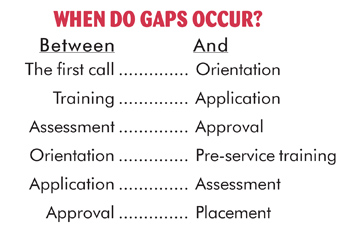 |
 |
 |
©
2008 Jordan Institute
for Families

Vol.
13, No. 3
July 2008
Tracking and Evaluation Are Key
Responses to the Division’s recent survey revealed inconsistent evaluation efforts on the part of county DSS agencies when it comes to foster parent recruitment and retention. This is a serious concern because to recruit a pool of resource families that reflect the ethnic and racial diversity of children in need of homes and to accurately evaluate the strengths and weaknesses of their recruitment efforts, child welfare agencies must have a thorough and integrated understanding of the characteristics of the children in foster care and the characteristics of its resource families. This is particularly true for targeted recruitment, which is one of the most effective ways of attracting the right kinds of families for the particular kinds of children in care (AECF, 2002).
Nationally, one thing some agencies are starting to track is the length of time each step of the recruitment process takes. These agencies seek to understand the reasons why people drop out. According to the Annie E. Casey Foundation, families are often lost in the transition between steps and multiple hand-offs from one staff person and/or stage of the process to another, which are illustrated below:

To learn more about this approach to enhancing recruitment efforts, consult “Recruitment, Training, & Support: The Essential Tools of Foster Care” <http://www.aecf.org>.